A Paipo Interview with Ian Peden
September 20, 2010. Coomba Park, New South Wales, Australia
Questions and e-mail interview by Bob Green
Photos courtesy of Ian Peden and Dennis Markson.
Ian was a bodysurfer from Maroubra in the 1960s who began riding and
experimenting with ply bellyboards.
Along with some of his friends he was featured in a 1965 Surfing World
article, one of the few articles with bellyboard content.
|
1. When did you start
bodysurfing? Where was this?
Not certain as
growing up in Maroubra and not far from the surf I was always at the
beach
and I guess as soon as I was able to swim with some confidence I expect
I was in the surf,
so age 6 or 7. Of course this would have been just catching breakers into
the beach. In the
early years bodysurfing generally meant catching waves into the beach
and avoiding getting
dumped. However the better surfers, generally from the surf club, also
would try and "corner the
wave," take off on a wave with a peak and ride the shoulder. Variations
on standard bodysurfing
(arms held along the sides) involved arms in front with hands linked
into a planning surface,
One arm in front with the hand planning with the other used as a
paddling arm, the use of a
handboard (usually a shaped ply board with a strap to hold the hand in
place).
My mates and I were into
cornering waves when we were around 10 or 11 and the break we
favoured best was off the stormwater drain where there is a bit of a
reef bottom that
shapes the banks. The other favoured break was the north point where
the rocks also play
a big part in shaping the break.
Ian
and John Dunn at Bawley Point in the 1960s. Photo Lindsay Harold.

2. Why did you first get into
bellyboards? How old were you at the time?
I don't know exactly,
I guess we saw the Club guys with their semi handboard/chest
board and had used "surfoplanes" and figured we would try a larger ply
board. It was
something different to do in the surf and they were more manoeuvrable
around the rocks.
I was around 13 or 14 years old, so around 1956/57.
3. Who else did you ride
bellyboards with? Were you involved with the lifesavers at the time?
The guys I grew up
with, went to school with, and hung out with. The same guys I was
still surfing with 10 years later on. I had a few friends in Maroubra
Surf Club and
occasionally surfed with them although they were more into club
competitions and also
were board paddlers and riders of 16 foot hollow boards -- the pre-balsa/
fibreglass revolution.
Ian,
John Dunn & Paul Kohler at Bawley Point in the 1960s. Photo Lindsay
Harold.
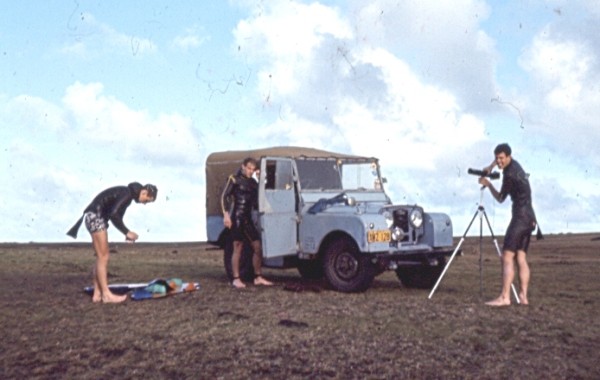
Lindsay
Harold - Great Barrier Island in the 1960s. Photo John Holden.
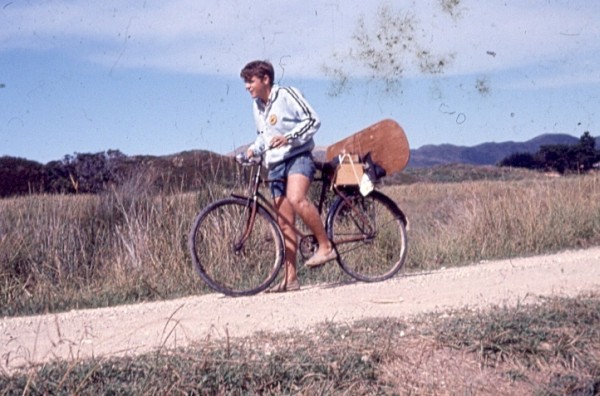
4. When you first started were
there other bellyboards or prone surfing craft around?
"Surfoplanes" were
the popular surf aid for prone surfing and of course you could hire
them at the beach so they were a cheap way for people to get the thrill
of riding a wave
to the beach.
5. Robert McDermott introduced
bellyboards to the Gold Coast around 1965. Did you
ride the same type of boards? If not, what was the inspiration for the
boards you rode
and how did you make them?
The board that Robert
McDermott is carrying in the photo is pretty much like the boards
we were riding in the early years at Maroubra. They were easy to make,
marine ply cut
to the shape you fancied and then coated with marine varnish; handles,
grab rail, fins
etc added if you were so inclined. I preferred to use the board without
handles as they
tended to get in the way when you positioned your hands to get the best
trim and the board
was easy to grab and pull through the back of the wave. If you did get
pounded the board
usually popped up not far from you. My early boards were without fin/s
as you could
generally hold into the wave face.
Pictured to the right is Dennis
Markson with a 'skimmer' ca. 1968/1969. Photo courtesy of Dennis Markson. |
|
 |
6. Did you experiment with
design much - for example, try fins, thicker boards, different shapes?
I made a few
different designs over the years, longer, thicker (5ply), kick-up in
the
nose, different shapes and fins of different types.
Ian's
most recent board. The board measures 35.5 inches x 23.5 inches (900mm
x 600mm) and 11-3/4 inches across the nose and a 7-inch tail (300mm and
180mm). It is 3-ply.
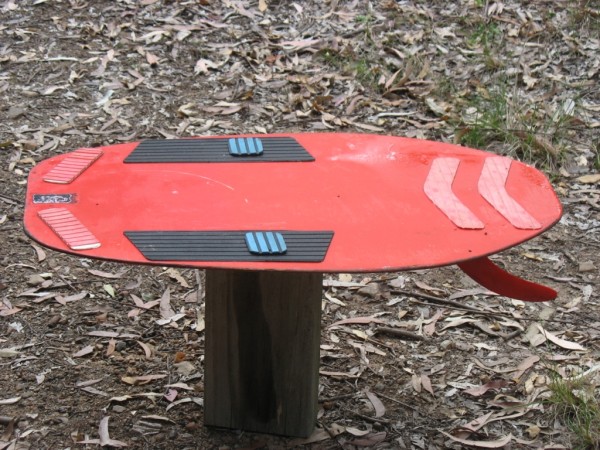
Ian's
most recent board. Bottom view showing single fin.
"I think I made that board in late 70s with that fin fibre-glassed in
place".
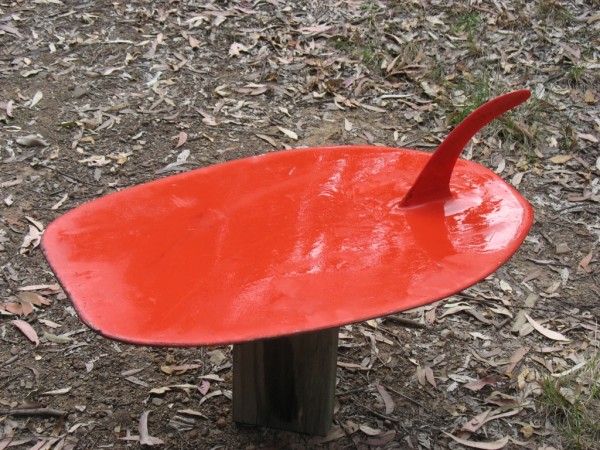
7. How important was flex to
the boards you rode?
I prefer to use a
board with flex as I find them more responsive and I believe this is
as a result of being able to get more variation in your centre of
gravity on the board
as opposed to a stiff board where the centre of gravity is more evenly
spread. The
result is more speed out of bottom turns and greater manoeuvrability on
the wave.
The big difference in body boarding vs stand up or knee boards; where
the centre of
gravity is much more varied based on feet placement and upper body
movement.
8. What type of wave did your
boards go best in?
On waves with a long
wall and not super hollow the original style of board without
fin/s was extremely fast in a straight line but as I found out on a
number of occasions
when the wave was large and hollow a fin was an advantage in holding
the best position.
Ian
down the south coast, 1966. Photo by Dennis Markson.

Ian
down the south coast, 1966. Photo by Dennis Markson.

Ian
going left at Bawley Point. Photo by Lindsay Harold.
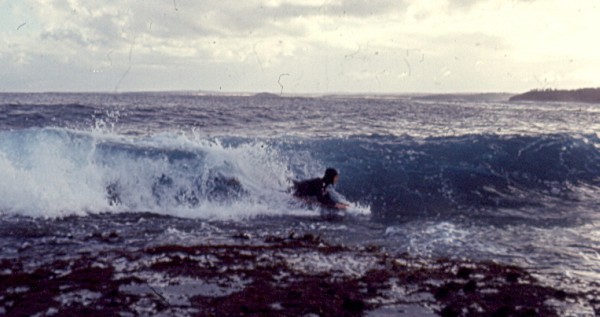
9. Are there any waves or
surfs that still stand out that you rode on your bellyboard?
My most memorable day
in the early years was at South Maroubra c1960 after school, westerly
howling offshore and lines of perfect hollow waves much too fast for
the body but great
with the body board.
North Avalon on the days
when the takeoff was out from the point, the waves big and
rides that you could make half way down the beach.
Newport Reef on a couple of
big days with a vertical takeoff and long right hand walls.
Just a couple days that stick in the mind.
10. What was the attraction of
a bellyboard to you? Is there much connection between
bellyboarding and bodysurfing?
Initially it was just
something different to do but as stand-up boards became shorter,
faster and more manoeuvrable it was getting harder to get good body
waves.
A bellyboard could compete with the boards and you could takeoff
further on the inside
than on the body.
Using a belly board is
somewhat like body surfing in that you get the same perspective
of the wave and the use of your swim fins and body positioning
determine placement in
the wave. However bodysurfing is more at one with the wave; you're part
of it, connected,
you feel every aspect through your body. A great wave surfed on the
body is unbeatable.
Aden
Parsons planing on the body at Little Avalon. May 1964. Photo Dennis
Markson.

11. Did you see many other
bellyboarders around?
Very few other than
my mates; at Little Avalon in the early 60s we surfed a couple of
times with a local who used a bellyboard and much later I used to see
Dick Ash at Avalon
with his Bellybogger.
I moved with my wife to
Avalon in 1970 and most of my surfing was then with Dick Evans
or on my own (of course with a host of boardriders) and we either
surfed on the body or
Dick rode a kneeboard and I rode a bellyboard.
Dick
Evans bodysurfing in the 1970s. Photo Ian Peden.

12. What was the story behind
the Surfing World article. How did you get to be involved?
Once our group became
mobile with a car we started checking out surfing spots up and down
the beaches and on one of our trips around 1962 we stopped at Avalon to
check out the
surf, on the road above Little Avalon and looked down on lines of waves
breaking on
this little reef with perfect hollow tubes and so began our love affair
with LA or
The Bin (as we called it borrowed from the name of the Hawaiian break
The Garbage Hole
which was also an extremely hollow wave).
Initially we surfed LA on
our own and on one of our visits we were joined in the surf
by an Avalon surfer on a belly board and a couple of other locals Rick
& John Howell
and Bob Comeys on the body and using hand boards. Dick Evans had heard
about LA and
joined us in the surf and John Pennings a friend of the local guys who
was keen on
surf photography and was writing articles for the magazines was on hand
and captured
one of the great days which was then featured in Surfing World. We told
the North side
guys about our favourite spot at home which was Lurline Bay where we
had the surf to
ourselves when it was working (big southerly swell and SW wind) and
John Pennings got
some photos on a reasonable (not great) day and wrote another article
for SW with the
classic photo of my mate Adin Parsons being the centre spread.
Pennings, John. (1965, May). New South Coast Discovery: Wilinga
Reef. Surfing World, 6(2), pp. 13-16. Photo by John Pennings.
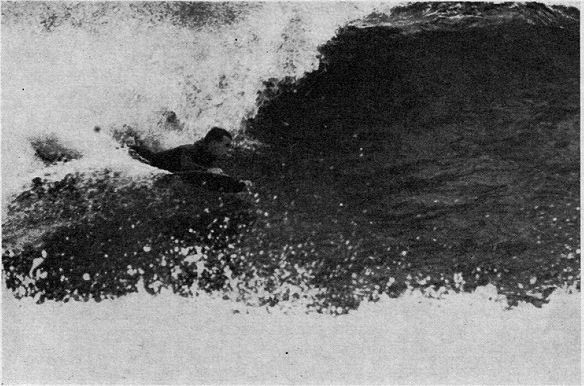
Pennings, John. (1965, May). New South Coast Discovery: Wilinga
Reef. Surfing World, 6(2), pp. 13-16. Photo by John Pennings.

Later on we organised a trip
down the coast with the guys and that then became the
article which had the bellyboard photos.
13. Were there many other
articles on bellyboarding?
I recall a few
articles in the magazines but not very often, it was like bodysurfing
something to add for novelty value, although on the rare occasions when
body surfing or
bellyboard/paipo riding was featured in a surf movie the audience was
generally stoked
as they tended to be classic rides. LA was featured in one of Bob
Evans' films, but
subsequently the film was destroyed in a fire at the production house.
14. When did you stop riding a
bellyboard? When was this? Any particular reason?
When the first Boogie
Boards came out I thought they might be the revolutionary board
that would replace the belly board. However the first Boogie boards
were slow and far
too flexible so although I bought one it didn't get ridden much and I
kept with the
belly board until the bodyboards improved in the 90s.
15. You tried Morey
boogieboards - when was this and how did they ride compared to the
boards you made?
As I noted, when
Boogie boards came out in the early 70s I tried them but found the
performance wanting but when they added a slick bottom to the board the
performance
had a dramatic improvement so I guess during the 80s I was regularly
riding my Boogie
board and less on the bellyboard except for big surf where the
bellyboard had better
performance. In the 90s the bodyboards being manufacture had improved
being thinner,
stiffer slick bottom and from that point I have hardly used my belly
board. In 96 on a
surfing holiday in Hawaii with my son I used a Mike Stewart model Morey
Boogie at
Pipeline and Sunset and was very pleased with the performance.
Ian (inside) at Pipeline in 1996, on a boogie board. Photo by Luke Peden.

16. Any other comments on
bellyboarding?
Great to see the
interest that you have generated amongst enthusiasts who love the
feeling of prone surfing.
|
|













